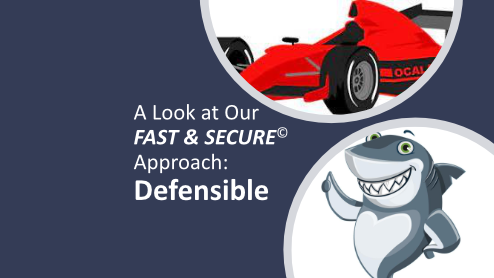
Welcome to our third focused article on our FAST & SECURE© approach.
Find, Assess, Share, and Trust the data through a Specifically Engineered process for Client-focused Usability, Reliability and Enforcement.
We will be looking at Defensible, and how it fits into our approach to eDiscovery. According to the Webster Dictionary, Defensible is defined as:
1: Capable of being defended, defensible theories, a defensible hill
A further check of the Webster Dictionary for Defend says:
a: To drive danger or attack away from – defend the castle from invaders.
b (1): To maintain or support in the face of argument or hostile criticism defend a theory – couldn’t defend their actions.
b (2): To prove (something, such as a doctoral thesis or dissertation) valid by answering questions in an oral exam – preparing to defend her thesis.
c sports: To attempt to prevent an opponent from scoring at – elects to defend the south goal.
It may feel as though you are defending your matter from the opposing team or enemy, fighting an uphill battle. This battle may be over an oral exchange of documents, facts, and other evidence, brought before an authority to decide. – Oh, wait isn’t that what happens in a litigation?
This is the case, but our focus is on the processes, procedures, and systems used to support them. In addition to whether they can withstand a thorough examination to show that everything was properly performed and that the results are what they are.
If we consider the processes and procedures we follow, there are a few aspects to examine, and with each, there are several questions I would challenge everyone to consider.
The Process/Procedure itself:
- Is it documented?
- Has it been updated and reviewed regularly to ensure it is up to date?
- Is it seen as a simple or complex task to complete – sometimes simple tasks do not get documented – but they should!
The Human Resources performing the process:
- Has the team been trained for the process and given the tools needed to properly execute?
- Is the team certified or do they have equivalent experience to confirm their abilities to succeed in general, or, specifically with the tools and technologies being used? (Check out our blog called Certifications Why?)
The Technologies:
- Are you using the latest version?
- Are you monitoring the release of updates?
- Are you involved in validating the newer versions prior to widespread use?
- Do you submit issues to the vendors to attempt to get resolutions for the issues that are being encountered?
- Are the technologies being evaluated/certified within the vertical they are being used for? ( eg: if using Forensic Software, is it being used by Law Enforcement or other Legal Service Providers? Does it have a good reputation, is it meeting a specific need, etc.). Do you periodically review and assess the technologies and whether there is a better one out there in the market that you should consider implementing?
The evidence of having followed the Process/Procedure:
- Is there evidence that you capture to show that the process was followed? (this may be achieved through tracking sheets or checklists)
- Do you periodically review/audit projects to ensure the required evidence was gathered and processes followed?
Where is the evidence stored:
- Do you have a Document Management system in place to keep everything organized? This can be a basic file share, SharePoint site, or some other enterprise system. Having everything in one place can be important when team members are searching for documents. Note: although storing everything in your email (foldered or not) may sound like the easiest and quickest place for you as an individual to locate stuff, there will be times where you will not be reachable, and other team members will be looking for pertinent information.
In this blog you can see terms like documentation; continuous improvement; calibration; education; certification; and auditing. These specific terms are regularly heard when talking about Quality and several other overarching ISO-type standards. (Check out our blog called Global Standards)
Additionally, these aspects are all evidence of a defensible process, so, if challenged that your output did not meet the requirements, you can show with confidence that your processes and procedures were followed. You will also be able to show that your processes and procedures are accurate, current, and appropriate for the task you were asked to perform.

Would you like to learn more about our services? Email [email protected] or call 289-803-9730. We would be happy to share more details about our self-service or fully managed eDiscovery services!





